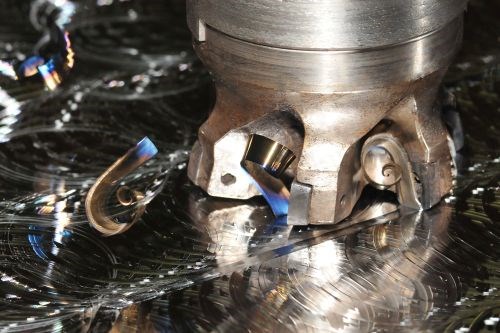High-Feed Tool, Deeper Cut?
Thick inserts make a high-feed tool this shop’s top choice for heavy roughing operations as well.

A close-up of the High-QuadF in action (photo courtesy of Ingersoll).
What’s the proper cutting strategy for a high-feed insert cutter? From what I’ve gathered, most experienced machinists would recommend cutting light, fast and shallow. Solid advice, to be sure, but one shop recently found an exception. Reko Manufacturing Group, part of Reko International Group, often turns to Ingersoll’s Hi-QuadF for relatively heavy-duty roughing operations despite the cutter’s designation as a “high-feed” tool. That’s largely thanks to the thick inserts, which provide sufficient strength for lighter and heavier cuts alike.
Despite the advantages of this tool, the shop wasn’t looking to improve roughing when it first turned to Ingersoll. Rather, it sought to improve cavity semi-finishing and finishing operations on its brand new five-axis machining center by changing from standard, button-style tooling to Ingersoll’s Power-Feed+ Mini high-feed face mill. Here, too, the shop realized significant gains. Read this case study to learn more about both applications.
Related Content
-
MMT Chats: The Connection Between Additive Manufacturing Education and ROI
This MMT Chat continues the conversation with Action Mold and Machining, as two members of the Additive Manufacturing team dig a little deeper into AM education, AM’s return on investment and the facility and equipment requirements to implement AM properly.
-
Machine Hammer Peening Automates Mold Polishing
A polishing automation solution eliminates hand work, accelerates milling operations and controls surface geometries.
-
Making Mentoring Work | MMT Chat Part 2
Three of the TK Mold and Engineering team in Romeo, Michigan join me for Part 2 of this MMT Chat on mentorship by sharing how the AMBA’s Meet a Mentor Program works, lessons learned (and applied) and the way your shop can join this effort.










.jpg;maxWidth=300;quality=90)


.jpg;maxWidth=970;quality=90)